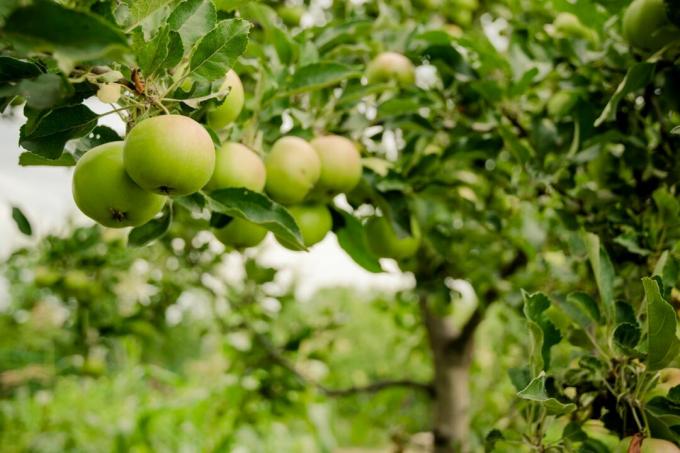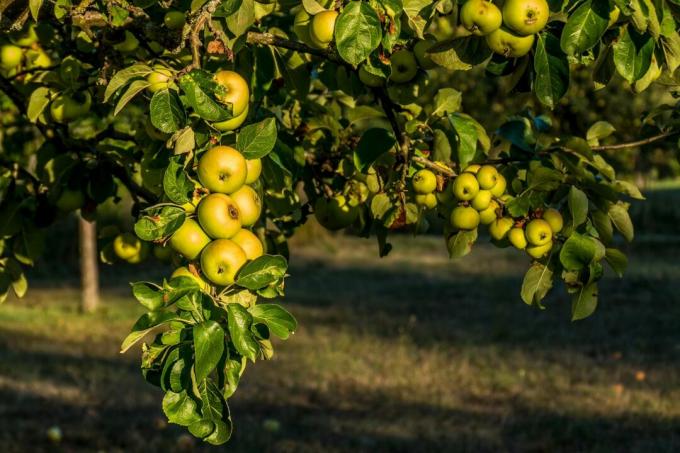The ‘Borowinka’ apple variety produces large fruits with light, light flesh. The variety of Russian origin was very popular for a long time, especially in Bavaria.

The ‘Borowinka’ apple has a couple of other names: Borowitzky ’, Charlamowski’ and simply August apple ’, but also‘ Oldenburger ’or‘ Duchess of Oldenburg ’. Due to the many synonyms, it is differentiated from other varieties, for example to ‘Privy Councilor Dr. Oldenburg ’, which is also called ‘Oldenburger’, not so easy at all.
contents
- ‘Borowinka’ apple: origin and history
- Taste and appearance of the ‘Borowinka’
- Growing and caring for the ‘Borowinka’ apple: this must be observed
- Harvest and use ‘Borowinka’
‘Borowinka’ apple: origin and history
At least one agrees on the rough origin of the ‘Borowinka’ apple. It is said to have been bred in southern Russia in the 19th century. From the end of the 19th In the early 1900s, the variety was popular in the foothills of the Alps and especially in Bavaria, but quickly found its way overseas, which is why it is also known in the USA. There is evidence that a ‘Charlamowsky’ apple was planted in Hohenheim near Stuttgart as early as 1804.
Taste and appearance of the ‘Borowinka’
The ‘Borowinka’ apple is a medium-sized to large apple with a flat-round shape. It has weak to moderately strong ribs. The base color of the shell is a light yellow, the surface color orange or light red washed out in stripes or flames. The peel is slightly frosted and shows typical white peel points.
The flesh inside is whitish to greenish white and loose, mildly sour and juicy with a weak aroma. The bite is juicy and crisp. The cores inside the core house are dashed in white.
The stem of the ‘Borowinka’ apple is long, thin and protrudes from the deep and wide, often rusted handle cavity.

Growing and caring for the ‘Borowinka’ apple: this must be observed
Because of its low demands, the ‘Borowinka’ apple tree is particularly suitable for extensive cultivation and also for poor fruit-growing locations. It can also exist in cool altitudes or in humid microclimates and on poorer soils. Because it forms a rather small crown, it is even suitable for smaller gardens without regular pruning.
However, the variety is short-lived, grows very strongly in the first few years, enters the fruiting phase early and then quickly forms aged crowns.
The flowering occurs early, but is hardly at risk of freezing due to its above-average frost hardness. ‘Borowinka’ is itself a good pollen donor and is safely fertilized by the Antonowka ’, Livonian Borsdorfer’ and ‘White Astrakhan’ varieties.
If the tree is either cut regularly or not at all, the yield is high and regular. However, radical cuts after years of neglect can lead to crop failures and irregular yields (alternation). For well-developed fruits, however, the tree should be cut annually in order to prevent the wood from overaging. Uncut and neglected, the robust ‘Charlamowski’ also looks good on orchards, where it produces rather small fruits.
Diseases and pests rarely affect the ‘Borowinka’, even in unfavorable locations.

Harvest and use ‘Borowinka’
The ‘Borowinka’ is an apple that is often harvested in late summer and cannot be stored for long, which explains its designation as the August apple ’. Some sources state that in good years it can be picked as early as August, so it is ready to be consumed by October at the latest. ‘Borowinka’ is mainly used for processing because of its massive yield, also because the taste is rather sour and the aroma is poor. The ‘Kharlamovsky’ can be used to make jelly or puree in late summer or early autumn, but the fruit hardly stays in storage for more than four weeks. A ‘Borowinka’ is an enrichment for every garden, even if it is not a perfect table apple for direct enjoyment. Further Apple varieties for the garden Discover in our overview article where particularly sweet, particularly crunchy, large, easy-care or beautiful varieties are presented, all of which are characterized by good health.


